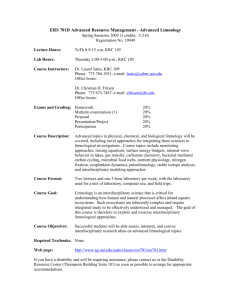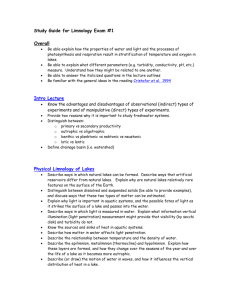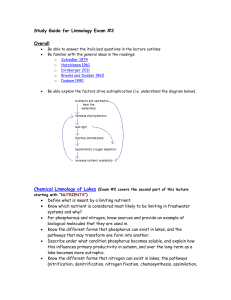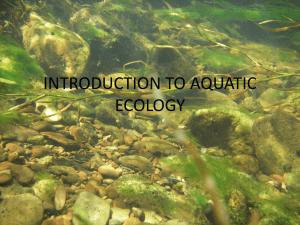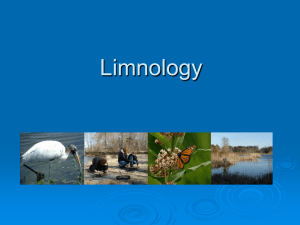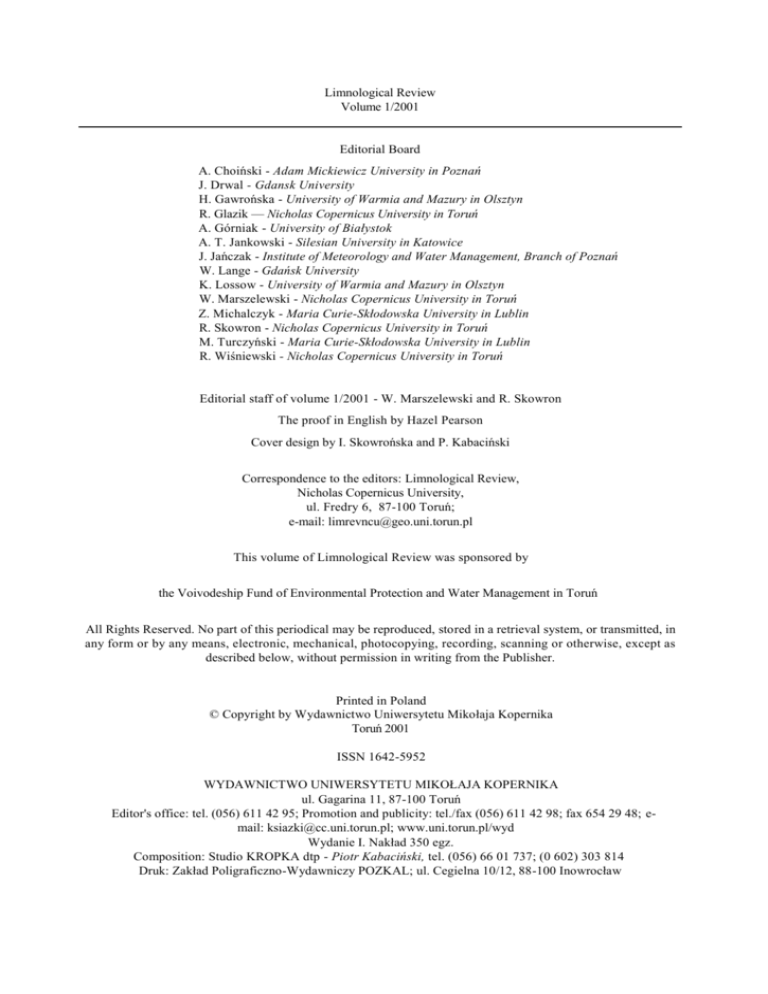
Limnological Review
Volume 1/2001
Editorial Board
A. Choiński - Adam Mickiewicz University in Poznań
J. Drwal - Gdansk University
H. Gawrońska - University of Warmia and Mazury in Olsztyn
R. Glazik — Nicholas Copernicus University in Toruń
A. Górniak - University of Białystok
A. T. Jankowski - Silesian University in Katowice
J. Jańczak - Institute of Meteorology and Water Management, Branch of Poznań
W. Lange - Gdańsk University
K. Lossow - University of Warmia and Mazury in Olsztyn
W. Marszelewski - Nicholas Copernicus University in Toruń
Z. Michalczyk - Maria Curie-Skłodowska University in Lublin
R. Skowron - Nicholas Copernicus University in Toruń
M. Turczyński - Maria Curie-Skłodowska University in Lublin
R. Wiśniewski - Nicholas Copernicus University in Toruń
Editorial staff of volume 1/2001 - W. Marszelewski and R. Skowron
The proof in English by Hazel Pearson
Cover design by I. Skowrońska and P. Kabaciński
Correspondence to the editors: Limnological Review,
Nicholas Copernicus University,
ul. Fredry 6, 87-100 Toruń;
e-mail: limrevncu@geo.uni.torun.pl
This volume of Limnological Review was sponsored by
the Voivodeship Fund of Environmental Protection and Water Management in Toruń
All Rights Reserved. No part of this periodical may be reproduced, stored in a retrieval system, or transmitted, in
any form or by any means, electronic, mechanical, photocopying, recording, scanning or otherwise, except as
described below, without permission in writing from the Publisher.
Printed in Poland
© Copyright by Wydawnictwo Uniwersytetu Mikołaja Kopernika
Toruń 2001
ISSN 1642-5952
WYDAWNICTWO UNIWERSYTETU MIKOŁAJA KOPERNIKA
ul. Gagarina 11, 87-100 Toruń
Editor's office: tel. (056) 611 42 95; Promotion and publicity: tel./fax (056) 611 42 98; fax 654 29 48; email: ksiazki@cc.uni.torun.pl; www.uni.torun.pl/wyd
Wydanie I. Nakład 350 egz.
Composition: Studio KROPKA dtp - Piotr Kabaciński, tel. (056) 66 01 737; (0 602) 303 814
Druk: Zakład Poligraficzno-Wydawniczy POZKAL; ul. Cegielna 10/12, 88-100 Inowrocław
Limnological Review 1(2001) 1-2
Introduction
Among naturalists there are several approaches
as regards the subject and scope of limnology.
The first of them draws on the definition formulated about 100 years ago by F. A. Forel and defines limnology as a discipline which is concerned
with research on lakes and which lies on the borders of hydrology, geography and biology. According to another view, limnology as the study of
lakes is part of hydrology, and limnological studies
and research may be conducted in several disciplines (for example, biology, chemistry, geography, physics and mechanics). The third view identifies limnology with the biology of all continental waters, and even with hydrobiology. Limnology
is, however, an interdisciplinary science which connects elements from biology, cartography, chemistry, climatology, ecology, geography, hydrology
and physics, and which gives special significance
to the environment surrounding lakes and in accordance with the International Hydrological
Dictionary - is concerned with studying lakes and
open water bodies. Such a definition of limnology
concurs with the view of F. A. Forel and seems to
be the most appropriate for the varied directions
of research on lakes, including the aspect of their
changes under the influence of natural and anthropogenic factors.
The problems connected with natural and anthropogenic changes of lakes and with the determination of their causes, effects, tendencies and the
methods allowing the rate of degradation, excess
eutrophication and the disappearance of lakes to be
checked are undoubtedly among the most important in contemporary limnology. They can only be
solved thanks to the integration and co-operation
of a wide range of specialists in limnology who are
joined by the common aim of their research - lakes
and their catchment areas. Such integrated co-operation among limnologists began in Poland in the
1980s, and its result was the scientific conference
organised by Nicholas Copernicus University in
1988, entitled ,,Natural and anthropogenic changes
of lakes and wetlands in Poland". Closer co-operation and exchange of views followed during subsequent national limnological conferences in the years
1997-2001, organised by Adam Mickiewicz University (1997), Gdansk University (1998), Adam
Mickiewicz University and Institute of Meteorology
and Water Management (1999), Warmia and
Mazury University (2000) and Nicholas Copernicus
University (2001), which were devoted to similar
problems. During these conferences the idea was
conceived of the need to publish a separate scientific periodical promoting scientific achievements
in this field.
The present volume is the first of a new series
of publications entitled Limnological Review.
The subject matter of this and subsequent volumes
will be all aspects and types of changes in lakes
and the search for and introduction of effective
methods to prevent the further degradation of the
whole lacustrine ecosystem. Papers concerning
artificial reservoirs may be presented within a narrow scope of research, especially as regards the
presentation of new research methods. Original,
unpublished research papers will be accepted for
publication. In accordance with the current plans,
Limnological Review will come out once a year.
We hope that the publications in Limnological
Review will contribute both to the development
of scientific knowledge in the sphere of limnology
arid to the elaboration and application of more effective methods for the protection of lakes. This
will be possible thanks to the presentation of the
results of studies and of opinions regarding the
causes and effects of any changes taking place in
lakes, including those that lead to their increased
eutrofication.
Wlodzimierz Marszelewski

